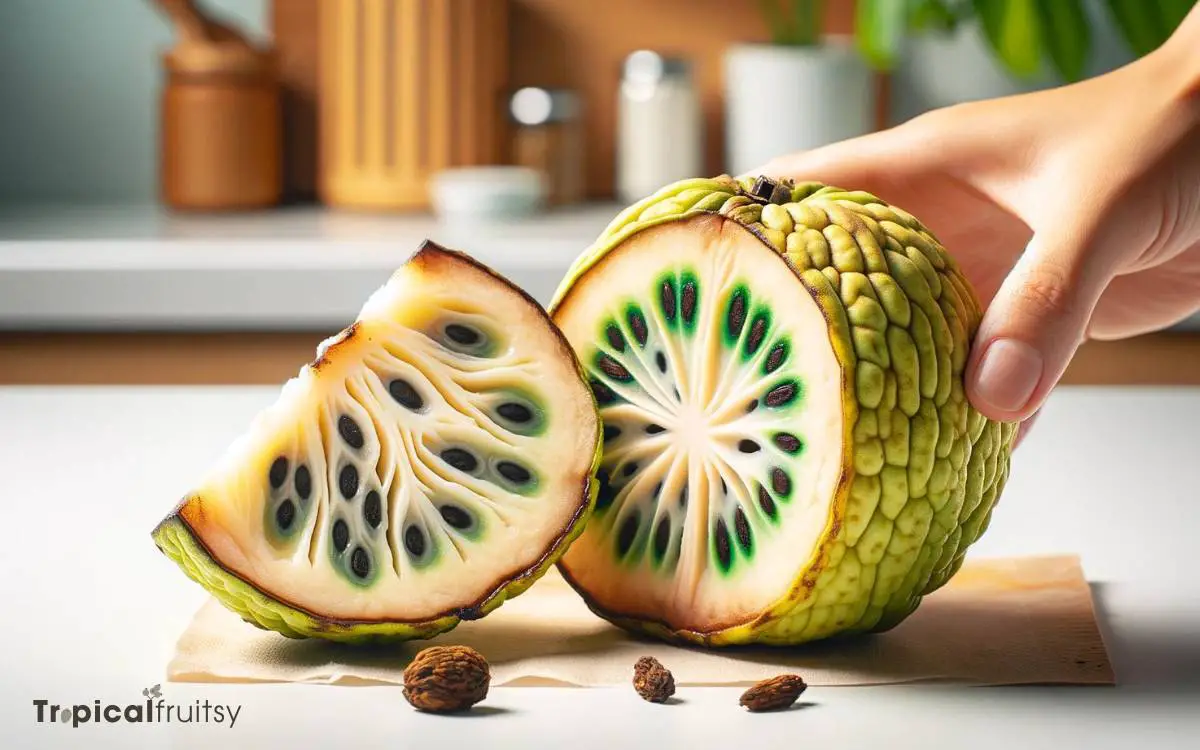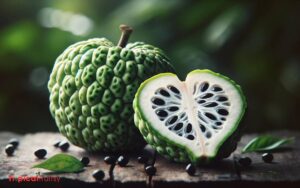How to Tell If Cherimoya Is Bad? 6 Easy Steps!
To determine if a cherimoya is bad, look for signs such as a very soft or mushy texture, dark spots or blemishes on the skin, an off or fermented smell, and any visible mold.
If the fruit also has an unpleasant taste or if the inside has turned dark brown or black, it is not good to eat.
Cherimoya, also known as custard apple, is a tropical fruit known for its sweet flavor and creamy texture. When ripe, it should be slightly soft to the touch, much like a ripe avocado.
Here’s how to tell if a cherimoya has gone bad:
When selecting cherimoya, always opt for those with a uniformly green color and a slight give to ensure you’re choosing a fruit that’s ripe but not overripe or spoiled.

Key Takeaway
Step 1: Inspecting the Skin
While inspecting the skin, it’s crucial to note that blemishes or black spots may indicate spoilage in a cherimoya. These imperfections often stem from microbial growth or enzymatic breakdown, both harbingers of decay.
A healthy cherimoya’s skin should exhibit a uniform green color with a slight give upon gentle pressure, signaling ripeness. Discoloration, especially dark patches, serves as a visual cue for internal degradation.
It’s imperative to assess the extent of these spots; isolated areas may simply suggest minor bruising, while widespread blackening typically denotes advanced spoilage.
An analytical approach requires one to consider the size, frequency, and distribution of such blemishes, as these factors collectively contribute to an accurate assessment of the fruit’s edibility.
Step 2: Checking for Softness
A cherimoya’s firmness is a reliable indicator of its freshness, with over-softness often signaling spoilage. As the fruit matures, its tissue structure begins to break down, resulting in a softer texture.
However, excessive softness, particularly when accompanied by other signs of deterioration, can indicate that the fruit is past its prime for consumption.
To assess this parameter scientifically, one should:
- Apply gentle pressure to the surface to gauge the yield.
- Note any areas that feel mushy or have lost structural integrity.
- Compare the resistance to that of a ripe, yet firm, cherimoya.
- Observe for any localized soft spots, which may suggest the onset of decay.
- Consider the overall uniformity in firmness, as inconsistent textures can reveal internal spoilage.
These steps provide a methodical approach to determining the edibility of a cherimoya based on its softness.
Step 3: Smelling the Cherimoya
The olfactory assessment of a cherimoya provides critical clues to its edibility. A sour or foul odor indicates microbial degradation, while an alcohol scent suggests fermentation, both signaling spoilage.
Distinguishing between the natural fragrant smell of ripeness and the pungent odors of rot is essential for ensuring consumption safety.
Sour or Foul Odor
Sniff the cherimoya for any sour or foul odors, as these scents indicate that the fruit may have gone bad. The detection of such odors is a critical step in assessing the quality of the cherimoya.
It’s important to note that:
- Fresh cherimoya typically emits a sweet, tropical fragrance.
- The presence of a sour smell suggests microbial spoilage.
- A foul odor may result from internal fermentation or rot.
- The olfactory assessment should be conducted in a well-ventilated area.
- Any off-putting smell is a reliable indicator of compromised fruit integrity.
An accurate olfactory evaluation is essential to prevent the consumption of deteriorated cherimoya. This leads to the necessity of discerning more subtle signs of spoilage, such as the detection of an alcohol scent.
Alcohol Scent Detection
Cherimoya’s aroma can reveal its freshness. If it’s emitting an alcohol-like scent, this often means the fruit’s interior has started to ferment.
The detection of an alcohol odor is an indication of overripeness. Naturally occurring sugars have begun converting into ethanol due to yeast activity.
This process, while common in fruit preservation methods such as winemaking, is undesirable in fresh fruit consumption.
Scientific analysis suggests that a cherimoya releasing a sharp, yeasty fragrance has undergone significant biochemical changes.
This can potentially compromise its flavor profile and nutritional value. Such an odor is a reliable marker for identifying spoilage, as it signifies a progression beyond optimal ripeness.
Recognizing the difference between the natural sweetness of a ripe cherimoya and the tang of fermentation leads to the next consideration: discerning ripeness versus rot.
Ripeness Versus Rot
When you’re checking a cherimoya for freshness, sniffing it out can quickly help you differentiate between the subtle sweetness of ripeness and the sour smell indicative of rot.
An analytical approach to assessing the scent involves:
- Identifying a fragrant, tropical aroma, which suggests optimal ripeness.
- Noting any fermented or alcoholic odors, which are red flags for overripeness.
- Detecting a vinegar-like or putrid smell that signals decomposition.
- Recognizing the absence of any strong smell as a potential indicator of an unripe fruit.
- Considering the intensity of the odor; a mild scent is generally favorable, while a pungent one may denote spoilage.
With the olfactory examination complete, one’s inquiry proceeds to evaluating the color, another crucial aspect for ensuring the cherimoya’s quality.
Step 4: Evaluating the Color
When assessing cherimoya’s edibility, scrutinizing the skin’s hue is imperative. A uniform green color indicates freshness, whereas discoloration may signal spoilage.
Additionally, brown spots on the flesh often denote decomposition and should be regarded as a warning sign.
Skin Color Changes
A cherimoya’s skin can reveal its freshness, with color changes often indicating whether the fruit has gone bad. As cherimoyas ripen, their skin transitions from vibrant green to a more muted tone.
However, certain skin color changes may suggest spoilage:
- Uniform Fading: A general lightening of color signifies maturity, not spoilage.
- Black Spots: Small black spots may appear as the fruit overripens.
- Large Discolorations: Extensive brown or black areas typically indicate decay.
- Yellowing: If the skin takes on a yellow hue, the fruit may be fermenting inside.
- Contrasting Patterns: Irregular coloring, such as blotches, can be a sign of bruising or rot.
Consumers should assess these visual cues critically to determine the cherimoya’s edibility.
Flesh Discoloration Signs
Beyond the skin, the flesh of a cherimoya offers further clues to its condition, with any discoloration typically signaling that it’s no longer good to eat.
When assessing cherimoya flesh, one should look for uniform creaminess. Deviations from this may indicate spoilage or internal bruising.
| Indicator | Meaning |
|---|---|
| Brown spots | Oxidation or beginning of spoilage |
| Dark streaks | Possible internal bruising or advanced decay |
| Excessive softness | Overripeness, which may lead to spoilage |
| Off-odor | Fermentation or microbial spoilage |
These visual and tactile signs are critical for determining the edibility of the fruit. A scientific approach to evaluating cherimoya involves observing for color changes, texture, and any unusual odors, all of which are quantifiable indicators of freshness or spoilage.
Brown Spots Presence
Observing brown spots on the surface of a cherimoya’s flesh often indicates the onset of spoilage.
These spots are typically symptomatic of the following conditions:
- Enzymatic Browning: A natural process often accelerated by damage or overripeness.
- Oxidative Stress: Exposure to oxygen can provoke discoloration, suggesting degradation.
- Fungal Growth: Brown spots may be indicative of fungal infection, which poses a health risk.
- Ethylene Exposure: This ripening agent can cause uneven ripening and spotting if not moderated.
- Senescence: As cherimoyas age, cells break down and blemishes appear.
The presence of brown spots is a quantifiable sign that the fruit’s quality is compromised.
Transitioning from visual cues to gustatory ones, it’s also crucial to assess the taste to determine if a cherimoya is past its prime.
Step 5: Assessing the Taste
One can immediately discern if a cherimoya has gone bad by its noticeably off flavor. The fresh fruit should have a sweet, slightly tangy taste, reminiscent of a blend of banana, pineapple, and strawberry.
A spoiled cherimoya, however, may have a sour or fermented taste, indicating microbial proliferation.
| Aspect | Fresh Cherimoya | Spoiled Cherimoya |
|---|---|---|
| Taste Profile | Sweet with tangy notes | Sour or fermented |
| Aftertaste | Pleasant and fruity | Unpleasant, often bitter |
| Texture Impact | Complements creamy texture | Overpowers natural creaminess |
| Ripeness | Indicative of perfect ripeness | Sign of over-ripeness or decomposition |
| Health Risk | Safe to eat | Potential for foodborne illness |
Consumers seeking to enjoy cherimoya without risk should rely on these taste indicators. Next, let’s transition to recognizing mold signs, another critical step in evaluating the fruit’s edibility.
Step 6: Recognizing Mold Signs
While inspecting a cherimoya, it’s crucial to look for mold, which appears as fuzzy spots or discolored patches on the skin or flesh. Mold indicates microbial activity, which can render the fruit unsafe for consumption.
To determine the presence of mold, one should conduct a thorough examination for the following signs:
- Fuzzy white, green, or black spots on the surface.
- Unusual brown or dark discolorations on the skin.
- A distinct musty odor, indicative of microbial proliferation.
- Soft areas that may feel spongy, a result of underlying mold growth.
- Visible filaments or spore formations, especially in advanced stages of decay.
These characteristics provide empirical evidence of mold contamination, and the affected cherimoya should be discarded to prevent potential health risks.
Conclusion
A cherimoya’s journey to the other side is signaled by its discolored skin, over-softened flesh, and an aroma that whispers of decay rather than tropical sweetness.
Upon investigation, if one observes an artistic display of mold or experiences a flavor that evokes a frown rather than a smile, it’s clear that the fruit has passed its prime.
Such scientific scrutiny ensures one can diplomatically part ways with compromised cherimoya, preserving only the freshest for consumption.






